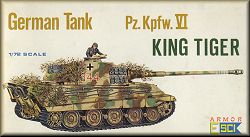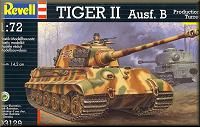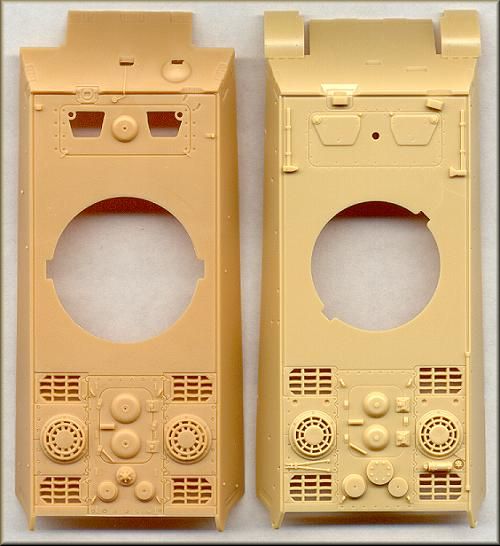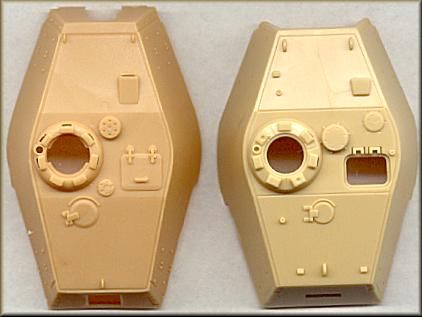| A Comparison of
the Revell and Italeri (ESCI) King Tiger Kits One would think that two kits, separated in release dates by at least 20 years, would also be separated by a comparable difference in quality. But that certainly is not the case for this pair of German heavies. The "new" Italeri King Tiger was released in early 2002 (the kit is a reissue of the original ESCI kit from the late 70's), and Revell's new offering hit the shelves a couple of months later. The expectation that the Revell kit would be light years ahead of the Italeri kit in overall quality was not realized. However, this is not due to any major deficiency of the Revell kit, but rather because of the very high quality of the original 1/72nd King Tiger from ESCI. Both kits have their strengths, and both have weaknesses (or oversights), and I hope that this article will highlight the pertinent spots for those modelers debating which kit to buy. Note: throughout this article, I will refer to the Italeri kit as the "ESCI kit" because they were the originators of the molds, and besides, that is the version of the kit which I own. King For a Day
When ESCI first released their King Tiger, it was considered to be one of the finest small scale tank kits of the day. And surprisingly enough, it still compares very favorably with today's newest releases. Yes, there are some archaic aspects to its design, such as double thick wheels, and very poor tracks, but talented modelers have not let these small inconveniences get in their way of building superb replicas, as can be seen in these Gallery contributions: The amount and finesse of the detail present on this kit was remarkable for its day. I have a full description of the kit, as well as scans of the kit parts in the ESCI King Tiger Preview. Specific comments about the pluses and minuses of this kit will be presented below, in the comparison. A Royal Succession
The new King Tiger from Revell AG. is almost everything we would expect from one of today's finest kit manufacturers. This model epitomizes accuracy in shape, size and detail. The two major flaws of the ESCI kit (the wheels and tracks) are completely blown away by this Revell kit. While researching the King Tiger for this article, I could find no errors in accuracy with this kit. My only complaints are regarding design choices, and lack of options. This is a supreme kit, and I look forward to seeing it built. You can find a full description of the kit, as well as scans of the kit parts in the Revell King Tiger Preview. Kingly Line-up Here I will present side by side scans comparing the major kit components for these two models. Unless otherwise noted, for all of these scans, the ESCI kit is presented on the left, and Revell on the right. Main Hull
There really is not a lot of difference between the two hulls, and for this component, I feel that the older ESCI part is better than the Revell. Revell has the front fenders molded onto the hull, giving the modeler the option of adding the side skirts. For the ESCI kit, the fenders are molded with the side skirt parts. Both kits have excellent detail: recessed hatch lines and bolt holes, engine grates molded through the hull, detailed hinges, and all of the appropriate accoutrements. But I feel that the areas where the ESCI kit beats the Revell kit are: the open hatches, separate periscope covers for driver and co-driver, no pioneer tools molded onto the hull, and the electrical wire for the headlight. But in Revell's favor, at least they include pioneer tools, even if they are attached to the hull; the ESCI kit includes only a couple of tools, and none of them are the ones we see on the Revell hull. Also, Revell depicts an armored cover on the center air vent (directly between the wire cutters and fire extinguisher). I'm not sure what ESCI was trying to achieve with theirs. It almost looks like an antenna mount, which Revell correctly molded immediatly to the right of the fire extinguisher. Despite that, if I had to choose, I'd say that ESCI has the better hull. Turrets
Revell takes the lead from ESCI with the turrets. The ESCI turret is a bit too elongate, with the turret roof a little too narrow. Although it appears in this scan that the ESCI turret is much longer than the Revell, it is deceiving, because the Revell turret does not have the front armored face attached, which is a separate part. With that part attached, the two turrets are essentially the same length. The width of the base of the turret is also very close, with Revell being just a little bit wider than ESCI. The walls on the ESCI turret have too steep of an angle to them, that is why the turret roof appears too narrow. Notice also the difference in the turret roof details, such as the location of the vent cover, close-in defence weapon port, and the spent shell ejection port. Suffice it to say that the location of these items on the Revell turret are correct. The Revell part also includes the pilzen (crane mounting sockets), seen on later examples of the tank. Not shown here is the rear hatch; both kits mold this hatch very well, with Revell having the armored hinge covers, which also is a feature of later tanks. Given the technical accuracy of the Revell turret, it is clearly the preferred part here, but most of the problems on the ESCI turret will only be noticeable to someone with scale plans in their hands. Rear Hull
These two parts are equally well molded, but with the Revell part including a couple of items that the ESCI part lacks, such as the tow cleats, and jack block. The block is actually anachronistic, since overall, the Revell kit depicts a late example of the tank, but the jack and block were deleted from the later vehicles. The jack itself is included as a separate part in the Revell kit, and not included at all in the ESCI kit. The vehicle exhausts (not shown here) are also better in the Revell kit, as they mold the exhaust pipe and armored cover as separate parts, whereas ESCI molds them together, making them look like a solid block, which is obviously incorrect. Also notice that the ESCI part is a little bit taller than the Revell. How this will appear on the final model, I don't know. Main Gun Barrels
In this scan, the ESCI barrel is on the top, Revell is in the middle, and I've included the turned aluminum barrel produced by ARMO at the bottom for comparison. I tried to line up the barrels at the right to show comparative lengths. As you can see, all three are different, but determining which one is correct is problematical, since none of the references I own seem to agree (listed below). The most dependable reference that I usually tend to follow is the Achtung Panzer volume, and for this review, I've compared the the measurements of the kit parts to the drawings in that book. The ESCI barrel is simply too large, measuring about 3.5 mm too long, and is shaped incorrectly. The baffle is a little too massive, but can be sanded down to proper size. The Revell barrel has the correct shape (i.e., correct proportional lengths of barrel segments), but is also about 2.5 mm too long. The ARMO barrel perfectly matches the dimensions in the Achtung Panzer reference. I think the best option here is to use the ARMO barrel with the baffle from the Revell part. Wheels
In this scan, ESCI is on the top, and Revell below. There are not many differences apparent in this scan. I feel that both manufacturers got the detail on these parts pretty much spot on, with the exception that ESCI molded the early type of sprocket wheel, which had 18 sprocket teeth, whereas there should be only 9 (the center hub is molded as a separate piece). I may be incorrect, but I believe that only the prototypes, and some of the early King Tigers with the Porsche turret had the 18-tooth wheel. I have never seen a photo of a Henschel King Tiger (as depicted by these kits) with the early sprocket. But that is certainly an easy flaw to fix. What is not easy to fix, however, and what is not seen in this scan, is that ESCI molded each pair of slim road wheels as a single, double-wide wheel. With the side skirts on, it may not be apparent (the inner wheels certainly won't be seen regardless), but the outer wheels may be visible. Other than cutting a thin groove down the centerline of each wheel, I can think of no other way to fix this. Tracks
In the track department, there simply is no comparison. The style of tracks you get with the ESCI kit are variable, depending on which release of the kit you find. The early releases had the single-piece vinyl tracks, and later releases included hard plastic, link-and-lingth tracks (pictured above left). The Italeri release includes both types. However, both types suck. The vinyl tracks are typical of that medium: very stiff, unresponsive, and lack any link detail on the inner surface. The guide teeth are mere bumps, and anyway are incorrect. The hard plastic tracks have better detail on the outside, and considering how they are molded, they will be easier to assemble, and look better on the final model. But they lack any detail whatsoever on the inner surface. The Revell tracks (above right) are absolutely first rate. Enough said. Miscellaneous Details Not pictured here, but available in the individual kit previews, are the other smaller details. Overall, Revell comes out on top here. The tow and track cables that are included in both kits are molded more finely in the Revell offering; Revell includes an AA machinegun and mount for the tank commander; several additional pioneer tools are included in the Revell kit; and the design of the chassis is superior on the Revell kit as well. However, there are some benefits to the ESCI kit too: the ESCI kit has no tools molded onto the hull, which on the Revell kit, look mediocre at best; as mentioned above, the hull hatches are molded open, and all of the periscope covers are also molded open. And finally, ESCI included three very well made crew figures in their kit (a full commander figure, and two busts for the driver and co-driver). Including figures is a kit feature that Revell has yet to embrace, much to the disappointment of many modelers. Scale With the ESCI turret and gun exceptions mentioned above, both kits scale out perfectly to 1/72nd. Conclusion So who makes the King of the Tigers? Nobody. If I wanted to build the perfect Royal Tiger, I would use the following: a Revell turret, with an ARMO gun, on an ESCI hull, with Revell wheels and tracks, and ESCI figures. And to top it all off, PART has already given us two etched brass sets (details and fenders) for the Revell kit, and I am sure that any day now, Extratech and/or Eduard will also be providing us with more options of etched brass details (and the obligate zimmerit from PART as well). Will any of these sets work with the ESCI kit? Considering how close the two kits are in size and details, I am sure that most, if not all, of the brass parts should be suitable for both. Will we see etched tracks? Not sure. They may be too thick for accurate representation in brass. Cast metal tracks for use on the ESCI kit sure would be nice, though. References
|







